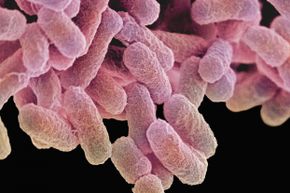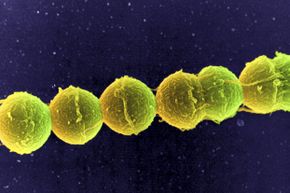Maybe you hover over the seat, or maybe you'd rather make a paper nest to protect yourself. Regardless of your choice of protection, you're not alone when avoiding the public seat. As many as 50 percent of women in the U.S. won't sit on a toilet seat in a public bathroom [source: ABC News]. Are we overreacting, or is there really a reason to assure our "assets" remain safe against what may be lurking on the toilet seat? We're talking about that which you can't see, not the mess the last user left behind.
Generally, you'll find about 50 bacteria per square inch on a toilet seat -- that's the average. While that may sound gross, there are definitely things around your house that are less clean in comparison. Your kitchen sponge, for instance, has about 10 million bacteria per square inch. That's 200,000 times dirtier than the toilet seat, and makes it pretty much the filthiest thing in your house [source: Pritchard]. Your cutting board, too, is a bacteria breeding ground, as are all your doorknobs. But that doesn't mean the toilet seat is off the hook.
Advertisement
Let's talk first about what everyone assumes you'll catch from visiting a public toilet. Sexually transmitted bacteria (such as chlamydia) and viruses (such as genital herpes) are passed along by skin-to-skin contact. Since those microbes die pretty much as soon as they hit the cold toilet seat, you can breathe a sigh of relief. It's so unlikely to catch an STI from a toilet that we're not going to mention it again. But there are a few infections that you really can pick up from an unsanitary porcelain throne, though the odds are still pretty low. But if you're at the right place (sitting on a toilet seat) at the right time (when the seat's contaminated with feces) it could happen (if you don't wash and dry your hands thoroughly).





